Sensory Analysis and Statistical Tools for Finding the Relationship of Sensory Features with the Botanical Origin of Honeys
Abstract
1. Introduction
- (1)
- color—from almost colorless to dark brown;
- (2)
- consistency—liquid, viscous, partially or completely crystallized;
- (3)
- taste—variable, depending on the variety;
- (4)
- smell—variable, depending on the variety.
2. Materials and Methods
2.1. Material
2.2. Sensory Evaluation of Varietal Honeys
- −
- age (25–40 years old), to ensure sensory maturity without reducing receptor acuity.
- −
- gender (5 women + 5 men), to minimize gender differences in perception.
- −
- experience, from newly trained to experienced, which enhances panel focus and calibration.
2.3. Statistical Analysis—Creating Sensory Profiles of Honey
2.4. Statistical Tools for Classifying Honey Varieties
3. Results and Discussion
3.1. Sensory Analysis—Profiles for Varietal Honeys from POLAND
- −
- sweet aroma—lime honeys (average 3.87 ± 0.84 points) and rapeseed honeys (average 3.63 ± 0.97 points);
- −
- bitter aroma—dandelion honeys (average 1.86 ± 1.29 points) and honeydew-conifer honeys (average 1.71 ± 0.77 points);
- −
- beeswax aroma—lime honeys (average 2.43 ± 1.42 points), honeydew and conifer honeys (average 2.25 ± 1.34 points) and phacelia honeys (average 2.21 ± 1.12 points);
- −
- floral aroma—phacelia honeys (average 2.27 ± 1.35 points);
- −
- metallic aroma—dandelion honeys (average 1.53 ± 1.14 points);
- −
- fruit aroma—heather honeys (average 1.40 ± 0.65 points), phacelia honeys (average 1.40 ± 0.82 points) and buckwheat honeys (average 1.44 ± 0.84 points);
- −
- spicy aroma—honeydew-conifer honeys (average 2.10 ± 0.77 points) and phacelia honeys (average 2.18 ± 1.22 points);
- −
- herbal aroma—heather honeys (average 1.68 ± 0.73 points);
- −
- tart taste—buckwheat honeys (average 2.08 ± 1.37 points), honeydew honeys and coniferous (2.09 ± 1.25 points);
- −
- sweet flavor in phacelia honeys (average 4.04 ± 0.67 points);
- −
- beeswax flavor—lime honeys (average 1.69 ± 0.88 points);
- −
- floral flavor—buckwheat honeys (average 2.16 ± 1.38 points), phacelia honeys (1.87 ± 0.89 points) and rapeseed honeys (1.95 ± 0.83 points);
- −
- tart flavor—buckwheat honeys (average 1.91 ± 1 points);
- −
- bland flavor—acacia honeys (2.11 ± 1.17 points);
- −
- spicy taste—honeydew honeys (average 2.05 ± 0.98 points), heather honeys (average 1.76 ± 1.24 points), phacelia (average 1.77 ± 0.92 points);
- −
- herbal taste—phacelia honeys (1.82 ± 1.12 points) and heather honeys (1.72 ± 1.04 points).
- −
- buckwheat (4.04 ± 0.81 points),
- −
- rapeseed (4.08 ± 0.71 points),
- −
- heather (4 ± 0.83 points).
- −
- acacia (average 3.15 ± 0.66 points),
- −
- honeydew and coniferous (average 3.24 ± 0.7 points).
3.2. An Attempt to Create Statistical Tools for Classifying Honey Varieties
3.3. Discussion
4. Conclusions
Author Contributions
Funding
Data Availability Statement
Conflicts of Interest
References
- Council Directive 2014/63/EC of the European Parliament and of the Council of 15 May 2014 Amending Council Directive 2001/110/EC Relating to Honey; European Parliament: Luxembourg, 2014.
- Bose, D.; Padmavati, M. Honey Authentication: A review of the issues and challenges associated with honey adulteration. Food Biosci. 2024, 61, 105004. [Google Scholar] [CrossRef]
- Cuevas-Glory, L.F.; Pino, J.A.; Santiago, L.S.; Sauri-Duch, E. A review of volatile analytical methods for determining the botanical origin of honey. Food Chem. 2007, 103, 1032–1043. [Google Scholar] [CrossRef]
- Wilczyńska, A.; Żak, N. Polyphenols as the Main Compounds Influencing the Antioxidant Effect of Honey—A Review. Int. J. Mol. Sci. 2024, 25, 10606. [Google Scholar] [CrossRef] [PubMed]
- Escriche, I.; Juan-Borrás, M.; Visquert, M.; Valiente, J.M. An overview of the challenges when analysing pollen for monofloral honey classification. Food Control 2023, 143, 109305. [Google Scholar] [CrossRef]
- Ntakoulas, D.D.; Tsagkaris, A.S.; Raptis, S.; Pasias, I.N.; Raptopoulou, K.G.; Kharoshka, A.; Proestos, C. Study of authenticity, quality characteristics and bioactivity in honey samples from different botanical origins and countries. J. Food Comp. Anal. 2024, 136, 106716. [Google Scholar] [CrossRef]
- Stolzenbach, S.; Byrne, D.V.; Bredie, W.L.P. Sensory local uniqueness of Danish honeys. Food Res. Int. 2011, 44, 2766–2774. [Google Scholar] [CrossRef]
- Regulation of the Ministry of Agriculture and Rural Development of 3 October 2003 on Detailed Requirements Concerning the Commercial Quality of Honey (Polish Journal of Laws 2023, Item 2513). 2023. Available online: https://www.ecolex.org/details/legislation/regulation-on-detailed-requirements-for-commercial-quality-of-honey-lex-faoc060166/?type=decision&xcountry=Brazil&xpage=3 (accessed on 12 August 2025).
- PN-88/A-77626; Polish Standard for the Properties of Honey. Wydawnictwo Normalizacyjne Alfa: Warszawa, Poland, 1998.
- Semkiw, P. Stan Pszczelarstwa W Polsce W 2024 R. Available online: https://www.inhort.pl/wp-content/uploads/2025/01/8.2_2024_Raport_stan_pszczelarstwa.pdf (accessed on 15 July 2025).
- Starowicz, M.; Lamparski, G.; Ostaszyk, A.; Szmatowicz, B. Quality evaluation of polish honey: On-line survey, sensory study, and consumer acceptance. J. Sens. Stud. 2021, 36, 10. [Google Scholar] [CrossRef]
- Kardas, M.; Staśkiewicz-Bartecka, W.; Sołtys, K.; Dul, L.J.; Sapała, A.M.; Kiciak, A.; Bielaszka, A.; Kardas, J. The quality of selected raw and pasteurized honeys based on their sensory profiles and consumer preferences. Front. Nutr. 2024, 10, 1330307. [Google Scholar] [CrossRef] [PubMed]
- Mongi, R.J.; Ruhembe, C.C. Sugar profile and sensory properties of honey from different geographical zones and botanical origins in Tanzania. Heliyon 2024, 10, e38094. [Google Scholar] [CrossRef] [PubMed]
- Vosoghi, M.; Yousefi, S.; Honarvar, M. Physicochemical and Sensory Properties of Honey Powder from Different Climatic Regions. Appl. Food Res. 2025, 5, 100843. [Google Scholar] [CrossRef]
- Manoko, M.L.K.; Mduda, C.A. Harvesting location influences the physicochemical properties, microbiological quality and sensory attributes of honey produced by an Afrotropical stingless bee, Axestotrigona ferruginea. Food Hum. 2024, 3, 100433. [Google Scholar] [CrossRef]
- Cabrera, M.; Santander, E. Physicochemical and sensory analysis of honeys from eastern Formosa province (Argentina) and its relationship with their botanical origin. Food Chem. Adv. 2022, 1, 100026. [Google Scholar] [CrossRef]
- Kortesniemi, M.; Rosenvald, S.; Laaksonen, O.; Vanag, A.; Ollikka, T.; Vene, K.; Yang, B. Sensory and chemical profiles of Finnish honeys of different botanical origins and consumer preferences. Food Chem. 2018, 246, 351–359. [Google Scholar] [CrossRef] [PubMed]
- Mahmoud, M.A.A.; Kılıç-Büyükkurt, Ö.; Fotouh, M.M.A.; Selli, S. Aroma active compounds of honey: Analysis with GC-MS, GC-O, and molecular sensory techniques. J. Food Comp. Anal. 2024, 134, 106545. [Google Scholar] [CrossRef]
- Sakač, M.; Novaković, A.; Ikonić, P.; Peulić, T.; Škrobot, D.; Radišić, P.; Šikoparija, B.; Jovanov, P.; Maravić, N.; Marić, A. Geographical origin authentication of honey produced in the region of Rtanj Mountain (Serbia). J. Food Comp. Anal. 2024, 129, 106088. [Google Scholar] [CrossRef]
- Castro-Vázquez, L.; Díaz-Maroto, M.C.; de Torres, C.; Pérez-Coello, M.S. Effect of geographical origin on the chemical and sensory characteristics of chestnut honeys. Food Res. Int. 2010, 43, 2335–2340. [Google Scholar] [CrossRef]
- Tahir, H.E.; Xiaobo, Z.; Xiaowei, H.; Jiyong, S.; Mariod, A.A. Discrimination of honeys using colorimetric sensor arrays, sensory analysis and gas chromatography techniques. Food Chem. 2016, 206, 37–43. [Google Scholar] [CrossRef] [PubMed]
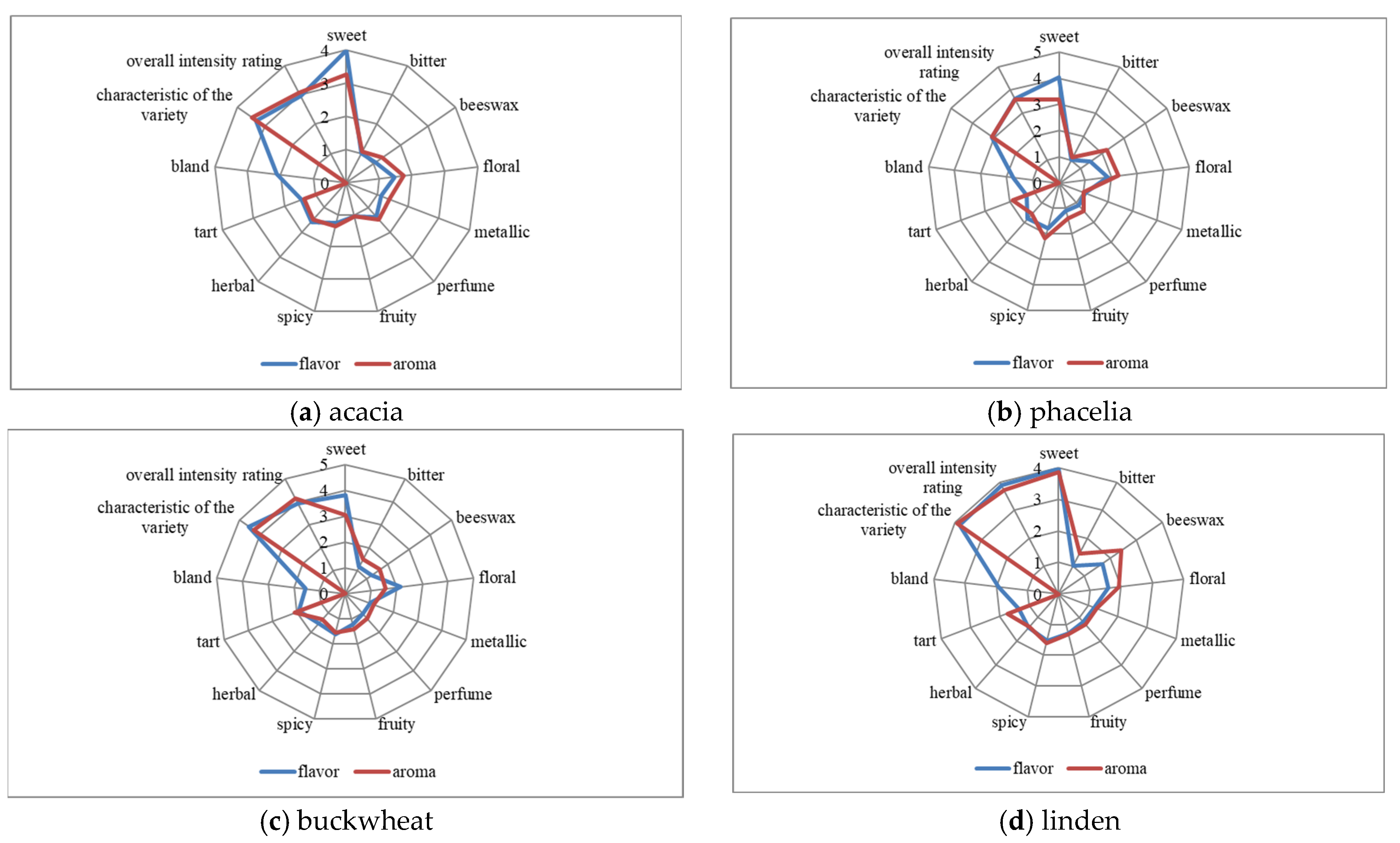
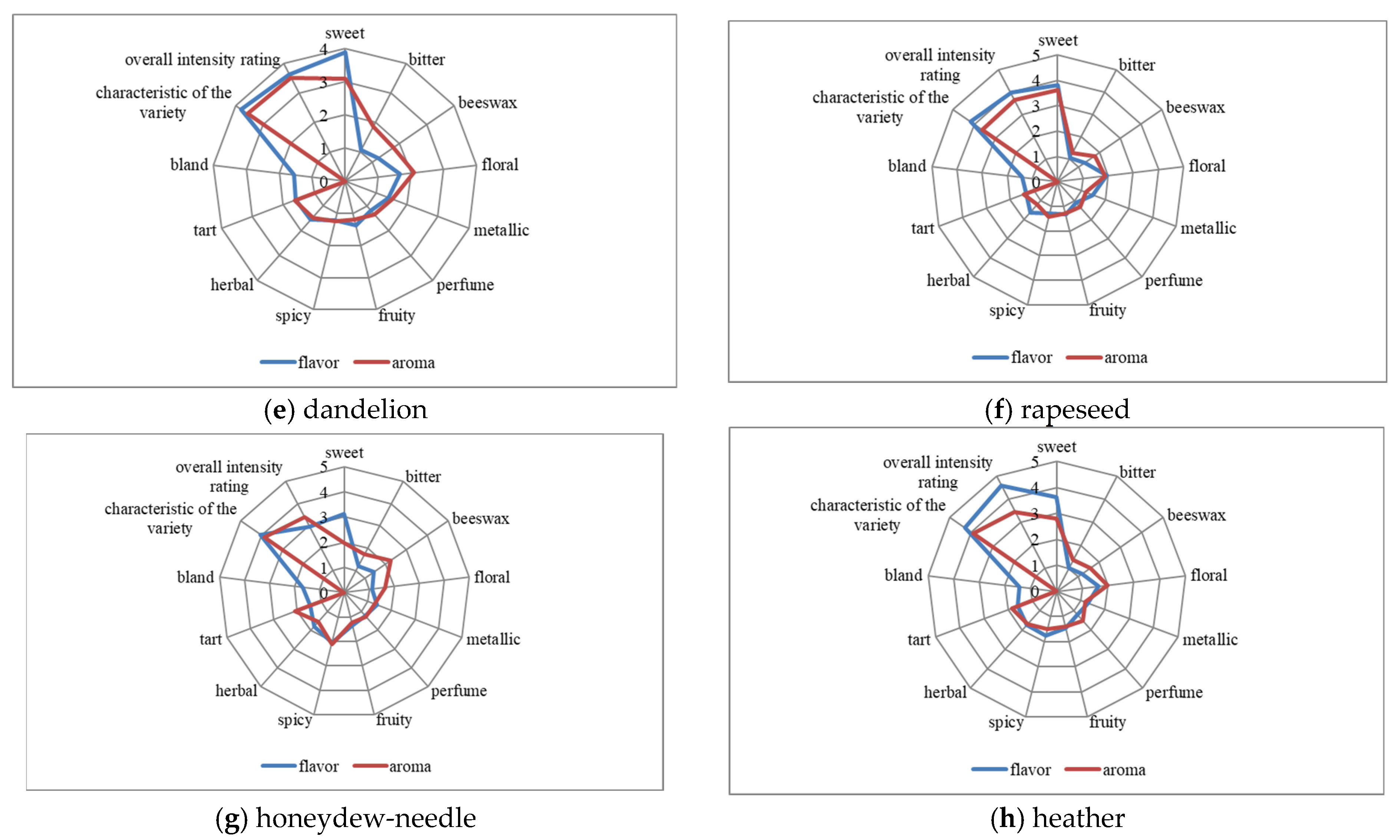
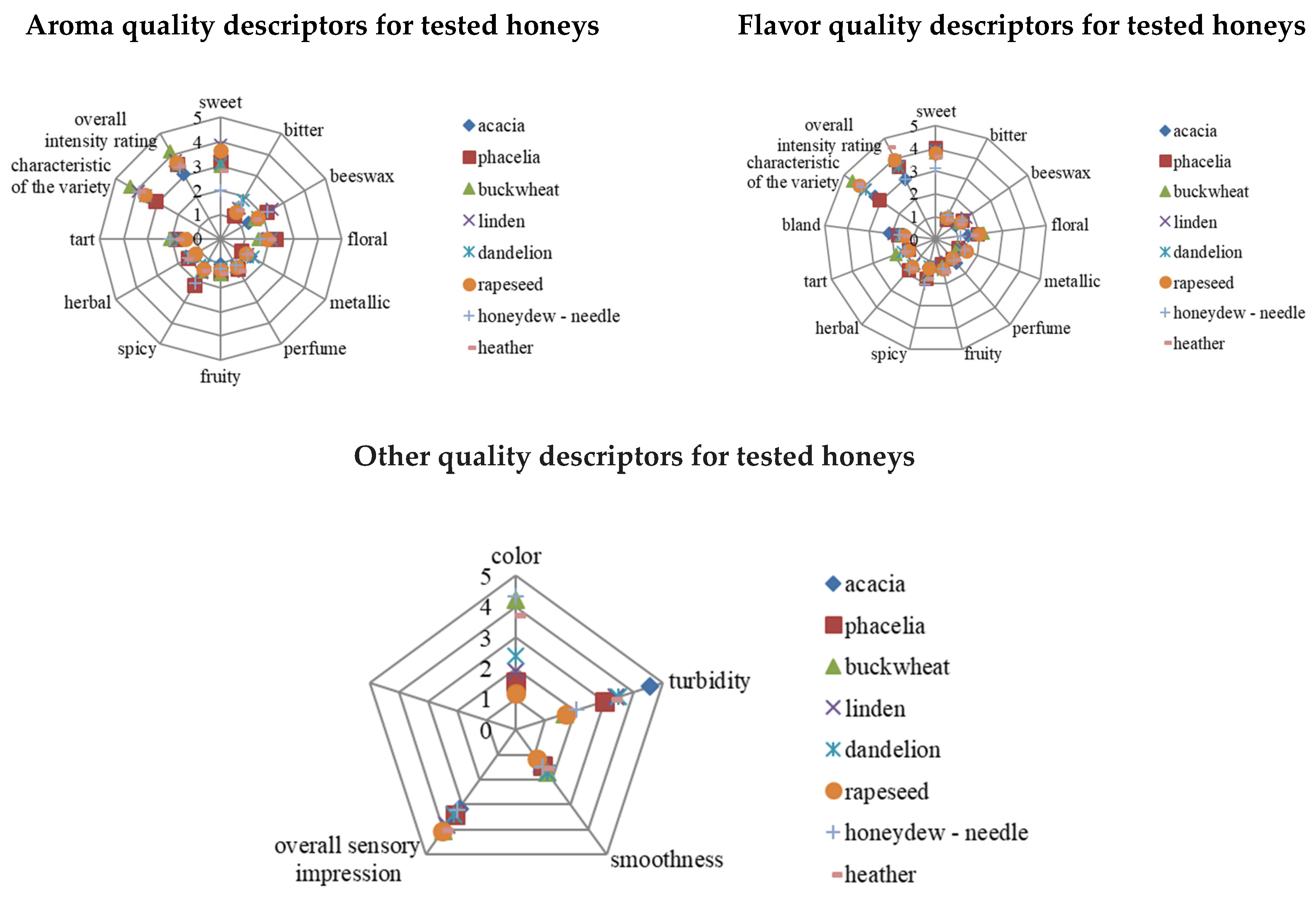
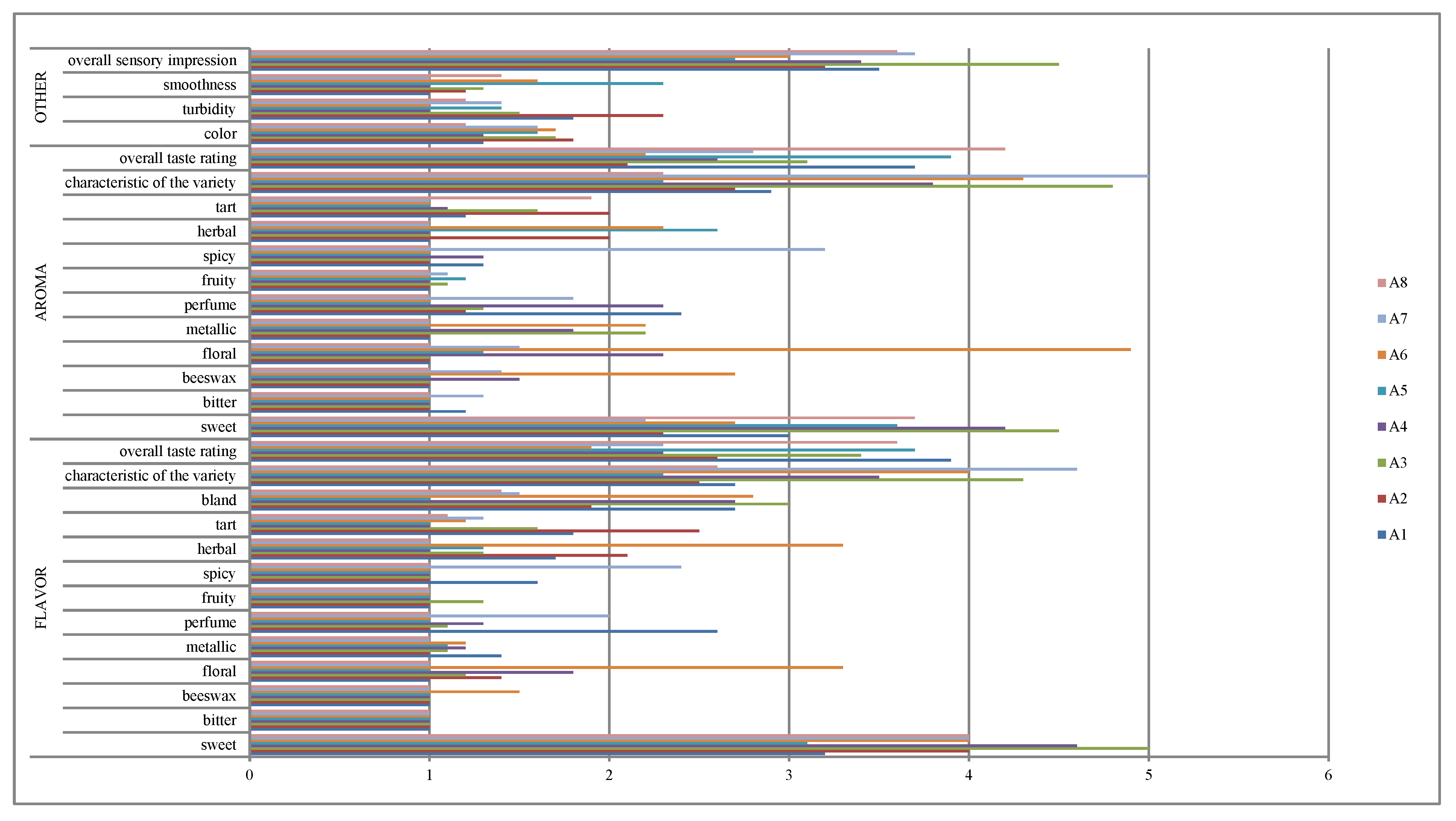
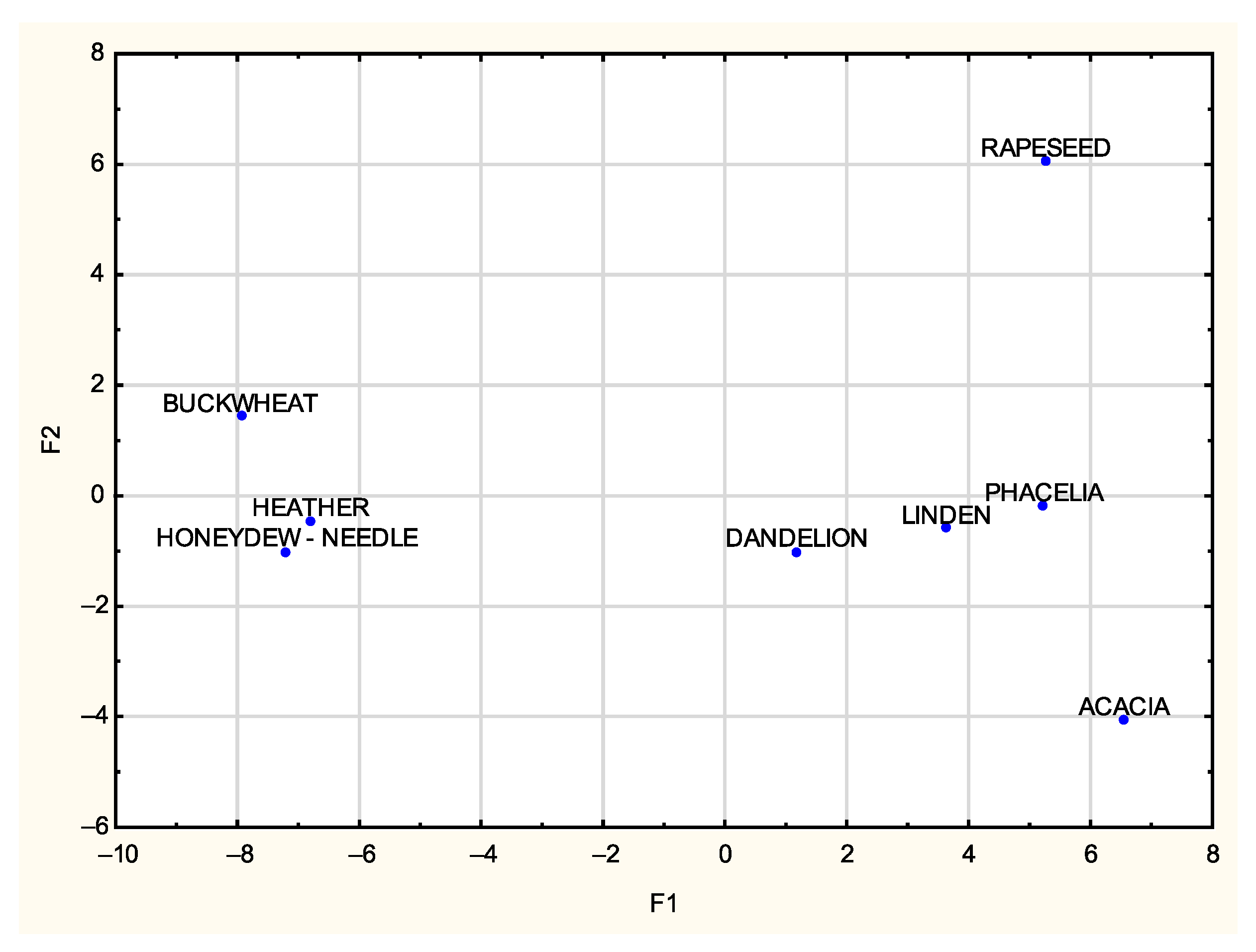
| Honey Variety | Color Before Crystallization | Color After Crystallization | Aroma | Taste | Consistency |
|---|---|---|---|---|---|
| rape | colorless to light cream | white or grey cream | weak, similar to the scent of rapeseed flowers | sweet, slightly bland | fast crystallization, gooey consistency |
| acacia | colorless to straw-colored | from white to straw | weak, similar to the scent of acacia flowers | sweet, slightly bland | thick liquid, crystallizing slowly |
| buckwheat | dark tea to brown | brown | strong, similar to the scent of buckwheat | sweet, sharp | coarse-grained crystallization, sometimes stratifies |
| honeydew | greyish-green to brown or almost black | dark brown with a grey or greenish tint | slightly spicy or resinous | Not very sweet, bland | fine-grained consistency |
| phacelia | from light cream to straw | white or creamy gray | weak, similar to the scent of flowers | sweet, refreshing, slightly sour | thick liquid, crystallizes quickly, fine-grained, greasy after crystallization |
| lime | from greenish yellow to light amber | from white-yellow to golden yellow | strong, similar to the scent of lime flowers | sweet, sharp with a bitter aftertaste | thick liquid, fine-grained, crumbly after crystallization |
| heather | reddish brown | yellow-orange or brown | strong, similar to the scent of heather flowers | low-sweet, sharp, bitter | thick liquid, gelatinous after crystallization, may be medium-grained |
| dandelion | from light cream to tea | from light yellow or light gray to light brown | strong, similar to the scent of beeswax | sweet, mild, to sharp, with a bitter aftertaste | thick liquid, medium-grained after crystallization |
| Lp. | Honey Variety | 2020 | 2021 | 2022 | 2023 | 2024 | N |
|---|---|---|---|---|---|---|---|
| 1. | ACACIA | 2 | 1 | 1 | 2 | 2 | 8 |
| 2. | PHACELIA | 2 | 2 | 2 | 2 | 1 | 9 |
| 3. | BUCKWHEAT | 3 | 3 | 2 | 3 | 2 | 13 |
| 4. | LINDEN | 2 | 3 | 3 | 3 | 3 | 14 |
| 5. | DANDELION | 2 | 2 | 2 | 2 | 2 | 10 |
| 6. | RAPESEED | 3 | 3 | 2 | 2 | 3 | 13 |
| 7. | HONEYDEW-NEEDLE | 1 | 2 | 1 | 2 | 2 | 8 |
| 8. | HEATHER | 2 | 2 | 1 | 2 | 2 | 9 |
| total | 17 | 18 | 14 | 18 | 17 | 84 | |
| Feature | Scale [pts] | ||||
|---|---|---|---|---|---|
| 1 | 2 | 3 | 4 | 5 | |
| Intensity of taste/smell | imperceptible | slightly noticeable | medium noticeable | very noticeable | strongly perceptible |
| Taste/smell characteristic of the variety | imperceptible | slightly noticeable | medium noticeable | very noticeable | strongly perceptible |
| Lightness of color | light | medium light | medium light/medium | dark | very dark |
| Transparency | very cloudy | cloudy | slightly cloudy | clear | transparent |
| Grainy | imperceptible | very delicately felt | delicately felt | noticeable | very noticeable |
| No. | Gender | Age | Experience/Role |
|---|---|---|---|
| 1. | W | 28 | freshly trained |
| 2. | M | 30 | panelist with one year of experience |
| 3. | W | 32 | experienced in fruit and honey evaluation |
| 4. | M | 27 | new, aroma sensitivity tested |
| 5. | W | 35 | floral aroma expert |
| 6. | M | 40 | panel calibration leader |
| 7. | W | 29 | honey texture and consistency tests |
| 8. | M | 38 | experienced in flavor analysis |
| 9. | W | 31 | deals with sweetness and acidity perception |
| 10. | M | 36 | honey aroma profiling specialist |
| Feature | Symbol | Description |
|---|---|---|
| Characteristic taste | CHT | A taste described as honey-like, desired for the honey of a given variety, e.g., buckwheat, taste characteristic of buckwheat honey. |
| Taste intensity | TI | A feature related to the uniformity of taste, described by the predominance of a given taste, from a weak sensation to a strong sensation. |
| Smell characteristic of the variety | S | A taste described as honey-like, desired for the honey of a given variety, e.g., the smell of lime in the case of lime honey. |
| Smell intensity | SI | A feature related to the uniformity of smell, describing the predominance of a given sensation. |
| Brightness of color | B | The degree of color saturation: from light cream, not very intense, to amber, a very intense color. |
| Transparency | T | A feature that is the degree of light transmission, characteristic of fresh honeys, especially acacia honeys. Often referred to as clarity or transparency of honey, but also as cloudy honey, not transparent. |
| Grainy | G | The consistency of honey is a feature that can indicate its freshness, e.g., the absence of lumps, smooth and creamy honey. Honey with lumps is honey in which the honey crystallization characteristic of this product has already occurred during its storage. This feature is indicated by the imperceptible presence of lumps and their perceptibility. |
| Acacia | Phacelia | Buckwheat | Linden | Dandelion | Rapeseed | Honeydew-Needle | Heather | ||
|---|---|---|---|---|---|---|---|---|---|
| Characteristic taste | 3.31 | 3.08 | 4.53 | 3.84 | 3.83 | 4.18 | 4.04 | 4.30 | |
| sd | 1.07 | 1.38 | 0.66 | 1.04 | 1.03 | 1.05 | 0.88 | 0.87 | |
| Average rank | 406.9 | 383.1 | 746.8 | 548.9 | 545.6 | 655.4 | 597.4 | 680.4 | |
| H | 208.79 | ||||||||
| p | 0.000 | ||||||||
| Taste intensity | 2.96 | 3.62 | 3.93 | 3.91 | 3.62 | 3.96 | 2.96 | 4.59 | |
| sd | 0.93 | 1.09 | 0.95 | 0.96 | 1.07 | 0.99 | 0.56 | 0.67 | |
| Average rank | 307.6 | 502.8 | 585.3 | 578.6 | 499.1 | 598 | 275.1 | 794 | |
| H | 193.15 | ||||||||
| p | 0.000 | ||||||||
| Smell characteristic of the variety | 3.46 | 3.10 | 4.30 | 3.93 | 3.58 | 3.62 | 3.88 | 3.93 | |
| sd | 1.16 | 1.35 | 0.85 | 0.97 | 0.84 | 1.02 | 0.91 | 1.08 | |
| Average rank | 511.7 | 438.2 | 751.2 | 644.3 | 541.2 | 552 | 627.4 | 643.9 | |
| H | 190.11 | ||||||||
| p | 0.000 | ||||||||
| Smell intensity | 3.08 | 3.58 | 4.15 | 3.72 | 3.52 | 3.65 | 3.38 | 3.47 | |
| sd | 0.85 | 1.15 | 0.86 | 0.95 | 0.9 | 0.99 | 0.49 | 1.09 | |
| Average rank | 407.7 | 567.8 | 742.5 | 614.7 | 541.7 | 594.4 | 480.4 | 539.6 | |
| H | 120.35 | ||||||||
| p | 0.000 | ||||||||
| Color | 1.53 | 1.57 | 4.22 | 1.89 | 2.39 | 1.19 | 4.34 | 3.74 | |
| sd | 0.53 | 0.52 | 0.92 | 0.66 | 0.53 | 0.4 | 0.73 | 0.74 | |
| Average rank | 289.3 | 302.1 | 915.6 | 398.2 | 547.9 | 187.4 | 942.7 | 851.6 | |
| H | 776.47 | ||||||||
| p | 0.000 | ||||||||
| Turbidity | 4.55 | 3.03 | 1.67 | 3.43 | 3.50 | 1.68 | 2.06 | 3.28 | |
| sd | 0.57 | 0.77 | 0.66 | 0.81 | 1.21 | 1.11 | 0.86 | 0.97 | |
| Average rank | 939.2 | 600 | 271 | 691.9 | 703.2 | 271.7 | 365.8 | 656.1 | |
| H | 438.9 | ||||||||
| p | 0.000 | ||||||||
| Smoothness | 1.35 | 1.44 | 1.74 | 1.37 | 1.71 | 1.16 | 1.48 | 1.54 | |
| sd | 0.62 | 0.75 | 0.98 | 0.55 | 0.71 | 0.37 | 0.62 | 0.77 | |
| Average rank | 492.3 | 514.7 | 601.5 | 513.8 | 644.3 | 422.9 | 556.1 | 559.8 | |
| H | 60.14 | ||||||||
| p | 0.000 | ||||||||
| Canonical Variables | Honey | |||||||
|---|---|---|---|---|---|---|---|---|
| Acacia | Phacelia | Buckwheat | Linden | Dandelion | Rapeseed | HoneydeW-Needle | Heather | |
| Averages of Canonical Variates | ||||||||
| F1 | 6.54 | 5.23 | −7.93 | 3.64 | 1.18 | 5.27 | −7.16 | −6.79 |
| F2 | −4.09 | −0.21 | 1.40 | −0.62 | −1.03 | 6.04 | −1.02 | −0.48 |
| Symbol | F1 | F2 | |
|---|---|---|---|
| Constant | - | 16.66 | −10.40 |
| Characteristic taste | CHT | −2.44 | 2.94 |
| Taste intensity | TI | −1.19 | 1.13 |
| Smell characteristic of the variety | S | 2.69 | −2.09 |
| Smell intensity | SI | −0.90 | −0.57 |
| Color | C | −4.76 | −1.25 |
| Turbidity | T | 0.25 | 2.18 |
| Smoothness | G | 1.43 | 0.69 |
Disclaimer/Publisher’s Note: The statements, opinions and data contained in all publications are solely those of the individual author(s) and contributor(s) and not of MDPI and/or the editor(s). MDPI and/or the editor(s) disclaim responsibility for any injury to people or property resulting from any ideas, methods, instructions or products referred to in the content. |
© 2025 by the authors. Licensee MDPI, Basel, Switzerland. This article is an open access article distributed under the terms and conditions of the Creative Commons Attribution (CC BY) license (https://creativecommons.org/licenses/by/4.0/).
Share and Cite
Żak, N.; Wilczyńska, A. Sensory Analysis and Statistical Tools for Finding the Relationship of Sensory Features with the Botanical Origin of Honeys. Appl. Sci. 2025, 15, 9427. https://doi.org/10.3390/app15179427
Żak N, Wilczyńska A. Sensory Analysis and Statistical Tools for Finding the Relationship of Sensory Features with the Botanical Origin of Honeys. Applied Sciences. 2025; 15(17):9427. https://doi.org/10.3390/app15179427
Chicago/Turabian StyleŻak, Natalia, and Aleksandra Wilczyńska. 2025. "Sensory Analysis and Statistical Tools for Finding the Relationship of Sensory Features with the Botanical Origin of Honeys" Applied Sciences 15, no. 17: 9427. https://doi.org/10.3390/app15179427
APA StyleŻak, N., & Wilczyńska, A. (2025). Sensory Analysis and Statistical Tools for Finding the Relationship of Sensory Features with the Botanical Origin of Honeys. Applied Sciences, 15(17), 9427. https://doi.org/10.3390/app15179427






